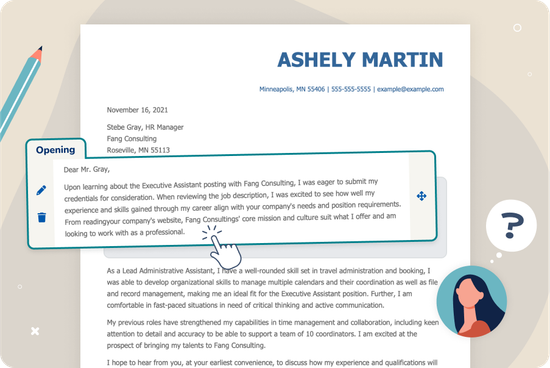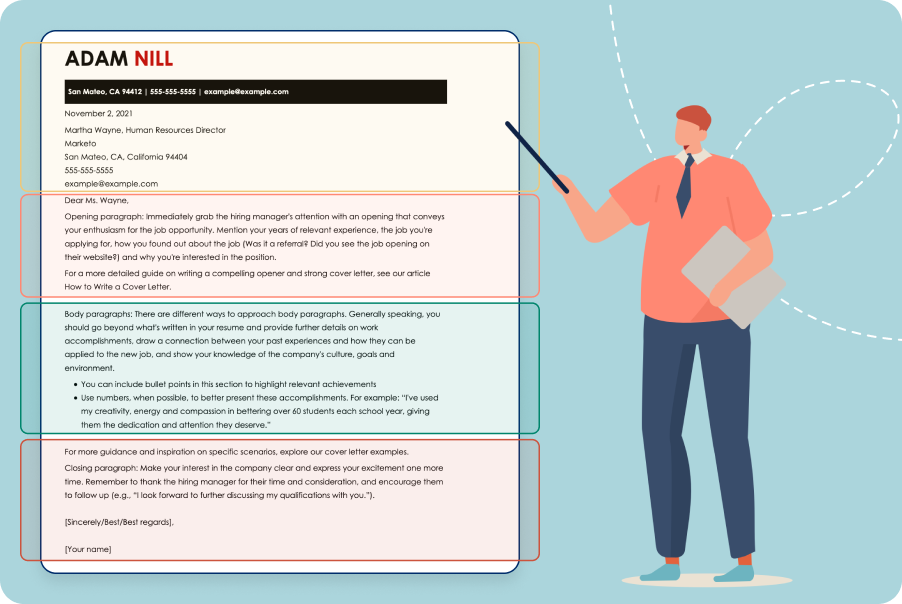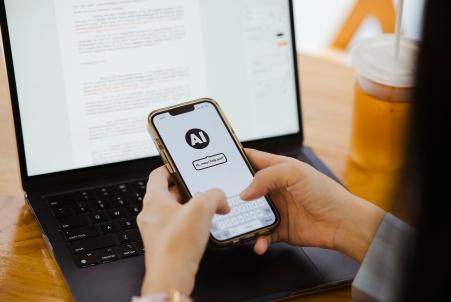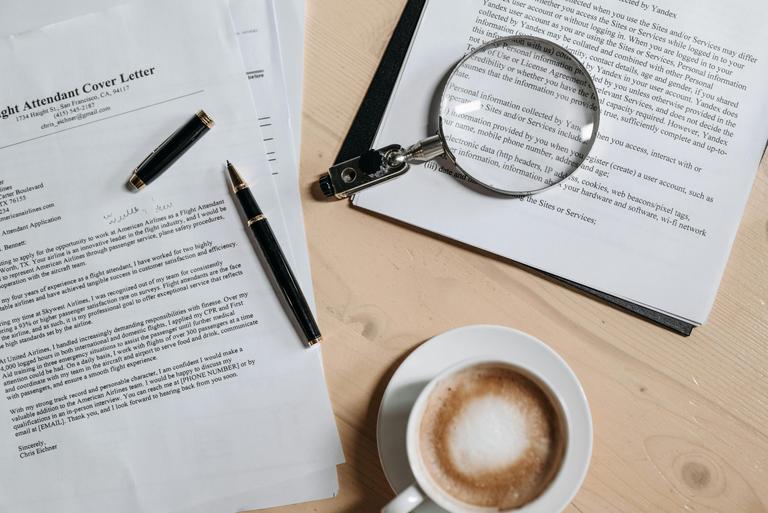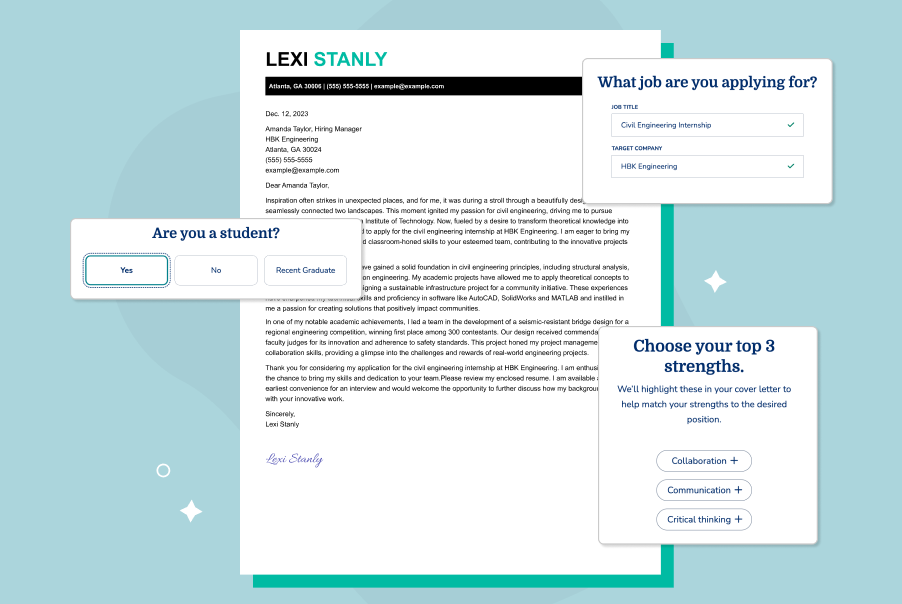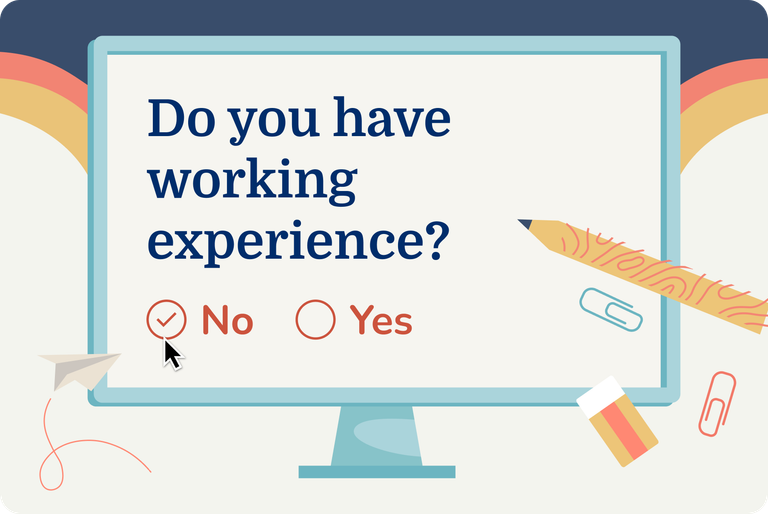Our customers have been hired at: *Foot Note
Your cover letter can be the difference between getting noticed and getting overlooked. It’s your chance to make a memorable first impression and show why you’re the perfect fit for the role.
In this guide, you’ll find step-by-step instructions on how to write a cover letter, along with expert tips and customizable examples to simplify the process.
The video below shows how to create a cover letter with our Cover Letter Generator—designed for fast, polished results on any device to save time and help you stand out.
Video: Learn how to make a cover letter with our Cover Letter Generator
What Is a Cover Letter for a Job?
A cover letter is a one-page document that accompanies your resume when applying for a job.
Unlike a resume, which lists your qualifications in a structured format, a cover letter allows you to showcase your personality, enthusiasm, and professional voice.
Think of it as your sales pitch to the hiring manager. This is your opportunity to explain why you are the best candidate for the job. A strong cover letter accomplishes the following:
- Introduces you professionally and sets the tone for your application.
- Highlights your most relevant skills and experiences tailored to the job.
- Demonstrates your enthusiasm for the role and the company.
- Shows your understanding of the company’s needs and how you can contribute.
- Encourages the hiring manager to read your resume and invite you for an interview.
What to Include in a Cover Letter
Before you start writing, it’s helpful to know the essential components that make a cover letter effective. Here are the key elements every cover letter should include:
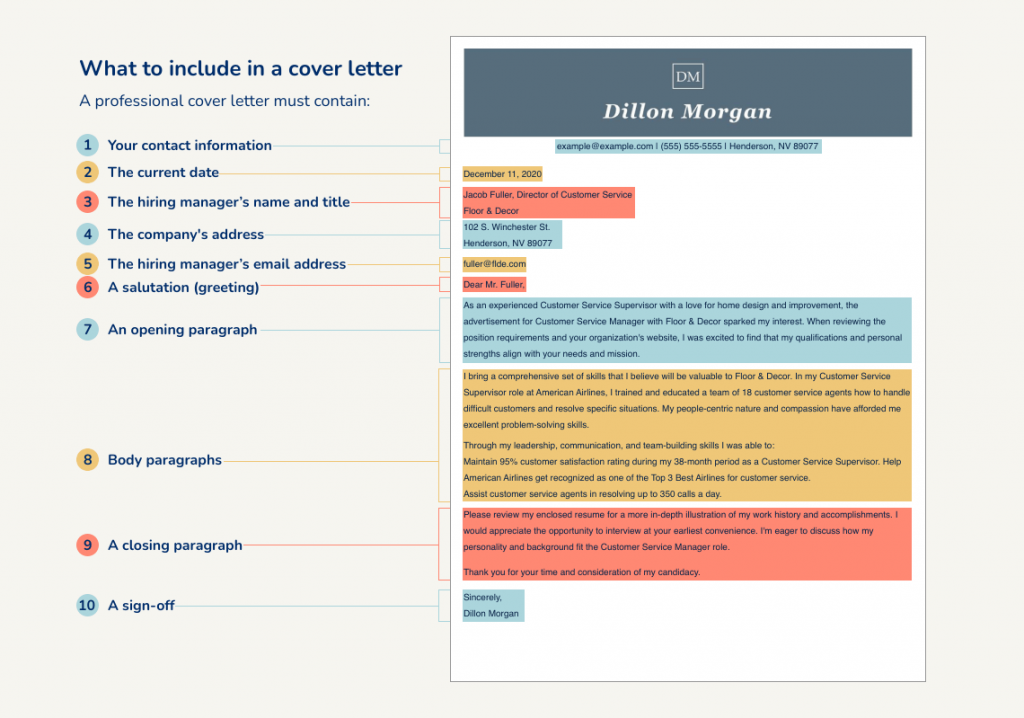
- Your contact information: Include your full name, address, phone number, and email address at the top of your cover letter, followed by the date.
- Potential employer’s contact information: If available, include the recipient’s full name, title, company name, and address.
- Salutation: Whenever possible, address your letter to a specific person or department (e.g., “Dear Mr. Smith,” “Dear Hiring Manager,” or “Dear [Company Name] Team”).
- Introduction: State the position you are applying for and where you found the job listing. Express your enthusiasm for the role and briefly introduce yourself.
- Body paragraphs: Highlight two to three key qualifications that align with the job description and provide specific examples of your impact in past roles.
- Signoff: End with a professional closing such as “Sincerely” or “Best regards,” followed by your full name. Optionally, include your contact details again beneath your signature.
How to Write a Cover Letter for a Job Application
STEP 1
Research the company
Take time to learn about the company and the role you’re applying for. This research will help you tailor your cover letter to show that you’re genuinely interested and a great fit for the team.
Here are a few tips for identifying the specific skills and qualities the employer values most:
- Review the company’s About Us page and mission statement.
- Check recent news or press releases for major updates or achievements.
- Explore the company’s social media to understand its tone and culture.
- Look for keywords in the job description that describe ideal candidates.
- Identify how your skills and values align with the company’s goals.
STEP 2
Choose a cover letter template
Using a professional cover letter template ensures your information is polished and easy to read.
Select a template that matches your industry and complements your resume design to create a cohesive job application that reflects your professionalism.
It’s also important to choose a template that’s compatible with applicant tracking systems (ATS), the software that many employers use to screen applications.
Opt for a standard cover letter format with standard fonts and clear sections, for example:
STEP 3
Add your contact information
Include a professional header at the top of your cover letter using the standard business letter format. Start with your full name, phone number, email address, and location (city, state, and ZIP code) so employers can easily contact you. Here is an example:

STEP 4
Include the recipient’s contact information
First, write the current date followed by a space. Next, add the recipient’s full name and title and the company name and address. A well-organized cover letter header sets a professional tone and ensures your application looks polished from the start. For example:
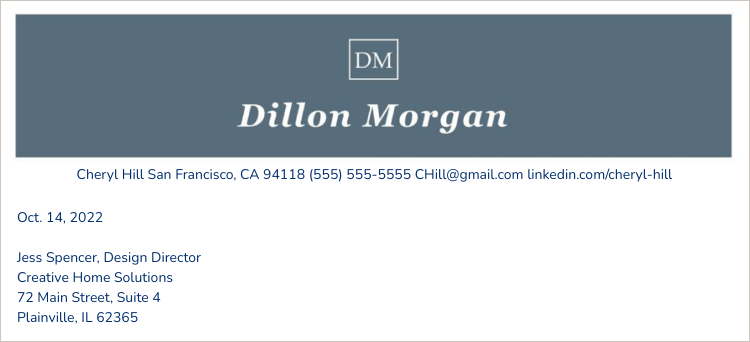
If a job description directs you to address your cover letter to a human resources team member or the HR department, use the information the prospective employer provides for the recipient’s address.
STEP 5
Greet the hiring manager
The salutation of your cover letter sets the tone for the rest of your message. Whenever possible, address your cover letter to a specific person rather than using a generic greeting.
Using the hiring manager’s name shows that you’ve done your research and adds a personal touch to your application. Address them as “Mr.” or “Ms.”, avoiding titles like “Mrs.” and “Miss” to prevent assumptions about marital status.
Alternatively, you can use their full name for a gender-neutral approach (e.g., “Dear Alex Taylor”). Steer clear of informal greetings such as “Hello” or “Hi,” as well as outdated salutations like “Dear Sir or Madam” or “To Whom It May Concern.”
If you cannot find a name, it’s acceptable to use a general greeting such as “Dear Hiring Manager” or “Dear [Department Name] Team.” See examples below for reference:
- Dear Lucy Garcia,
- Dear Ms. Lowe,
- Dear Hiring Manager,
- Dear Vice President of Marketing,
- Dear Lucy Garcia,
- Dear Ms. Lowe,
- Dear Hiring Manager,
- Dear Vice President of Marketing,
STEP 6
Craft a compelling introduction
The opening sentences of your cover letter serve as your elevator pitch, so it’s crucial to clearly and succinctly convey why you’re the ideal candidate for the role. Explore cover letter introduction examples below to discover strategies for grabbing the reader’s attention.
Assert your interest in the company
One effective method for starting a cover letter is expressing genuine enthusiasm for the company by touching on how its values align with your own. For example:
“I was excited to see that Tech Solutions, a company I admire for its commitment to innovation, has an opening for an experienced Lead Producer. With over 10 years of experience managing cross-functional teams and delivering high-quality projects on time, I am eager to bring my leadership skills and creative problem-solving abilities to your team. I am particularly drawn to Tech Solutions because of your focus on developing cutting-edge software solutions that streamline workflows for clients, and I am confident that my background in project management and digital product development aligns perfectly with this role.”
Highlight your career story by emphasizing key accomplishments and experiences relevant to the role. Explain why you want the job at the specific company, showing your interest in the company’s mission and values. This personalized approach can set you apart from other candidates.
– Toni Frana, Career Expert
Emphasize job-relevant skills
You can also kick off your cover letter with a strong introduction that highlights your most relevant skills and experiences. Clearly articulate how these qualifications make you an excellent fit for the role, setting the stage for a compelling case. Here is an example:
“With seven years of experience in production for leading startup companies in Silicon Valley, I have developed in-depth knowledge of cybersecurity and cloud computing, along with hands-on experience in artificial intelligence. I am confident that my experience managing complex projects, coordinating cross-functional teams, and delivering high-impact solutions aligns perfectly with the needs of your team.”
Highlight a measurable accomplishment
Showcase your qualifications by mentioning an impressive award, honor, or measurable accomplishment from a past role or two. For example:
“As director of Visit Mass, I developed and implemented tourism programs that led to a 30% increase in international visitors to Massachusetts in 2019. I am excited about the opportunity to bring my strategic planning and leadership experience to Global Travel Co., a company I admire for its innovative approach to expanding international tourism and creating unforgettable travel experiences. I am confident that my background in program development, marketing strategy, and stakeholder collaboration aligns perfectly with this role and will allow me to drive meaningful results for your team.”
Tell a compelling story
Tell a story about why you are applying. Discuss how your passion and motivation have driven your career choices and how they align with the position and company. For example:
“When I was a child, I spent my days in the city parks around my neighborhood, listening to birds sing and watching squirrels jump through trees. Those days instilled a passion in me for wildlife that has intensified over the years and, combined with admiration for the animal rehabilitation programs at Prospect Park Nature Conservancy, led me to apply for the Wildlife Technician position at the conservancy.”
STEP 7
Write the body paragraphs
Your cover letter should include one or two body paragraphs that explain why you’re the best candidate for the job. Here are a few key tips to keep in mind:
- If you have work experience in your target role or industry, highlight your key accomplishments and use numbers to quantify your impact.
- If you’re applying for your first job, connect the new opportunity with a personal or school project, extracurricular activity, or internship.
- Highlight relevant skills from your experience and explain clearly how you can apply them directly if hired for the role.
- Demonstrate alignment with the company’s culture or mission, such as through volunteering or personal interests that align with their values.
- If you’re changing careers, focus on transferable skills that demonstrate your ability to succeed even without direct experience in the field.
Here is an example of how to write the body paragraphs of a cover letter:
“In my most recent role as a marketing coordinator at BrightEdge Solutions, I led the launch of a digital campaign that increased lead generation by 37% in just three months. I also collaborated with the sales and design teams to streamline content production, cutting turnaround time by 25% while boosting engagement across email and social platforms. My experience managing multiple campaign channels—from paid social to SEO content—has equipped me to step into a fast-paced role and make an immediate impact.
What draws me to WILCO is more than your reputation—it’s your commitment to belonging and creativity. I bring not only a strong analytical mindset but also a genuine passion for brand storytelling that resonates with diverse audiences. Whether it’s running A/B tests to optimize conversion rates or crafting messaging that reflects a company’s core values, I take pride in delivering marketing that’s both strategic and human.”
STEP 8
End strong with a closing paragraph
Your closing paragraph should reiterate your enthusiasm for the role and the company, summarize why you’re a strong fit, and express your interest in an interview. Keep it concise and professional, and include a polite call to action, such as thanking the reader for their time and consideration. Here are a few examples of how to end a cover letter:
“I would welcome the chance to learn more about your upcoming initiatives and explore how my skills can support your marketing goals. Thank you for your time and consideration—I look forward to the possibility of contributing to the WILCO team.”
“Thank you for your time and consideration. I’m excited about the prospect of working for the Museum of Ancient History. I look forward to discussing what I learned in my year abroad as an English teacher and how I can apply those lessons to the docent role. Feel free to contact me any time during the week.”
“I’m confident that a review of my resume and portfolio will convince you that I have the technical skills and knowledge necessary to be successful in the lead designer role at Creative Ads, LLC. I’m excited about the opportunity and would be thrilled to meet with you and your team next week to discuss my ideas for your next campaign. Please contact me this week to schedule a convenient date and time.”
Are you searching for remote jobs? Our sister company, FlexJobs, updates listings daily with verified remote jobs. Find full-time and part-time remote jobs with FlexJobs.
STEP 9
Sign off professionally
End your cover letter with a professional and polite closing. This demonstrates your attention to detail, professionalism, and respect for the hiring manager and the company.
Make sure there’s enough space between your closing and your typed name to leave room for a signature if submitting a printed letter.
See how to write a proper cover letter signoff below (and what language to avoid):
- Sincerely,
- Best regards,
- Kind regards,
- Thank you,
- Yours,
- Take care,
- Cheers,
- Thanks!
STEP 10
Proofread your cover letter
Before sending your cover letter, carefully review it for spelling, grammar, and formatting errors. Reading it aloud can help you catch awkward phrasing or typos. It can also be helpful to have a friend, mentor, or career advisor review it for clarity and professionalism.
A well-proofread letter demonstrates attention to detail and makes a strong, polished impression on hiring managers. Here are a few key areas to review:
- Content and clarity: Ensure each paragraph clearly communicates your qualifications, relevant skills, and interest in the role, removing unnecessary words as needed.
- Accuracy and personalization: Double-check names, titles, company details, and any numbers or achievements you mention.
- Professional tone and formatting: Ensure language is polished and professional, avoid slang or casual phrases, and keep font, spacing, and margins consistent.
- Call to action and contact information: Confirm your closing expresses enthusiasm for an interview, and that your phone number, email, and LinkedIn are correct.
Examples of Effective Cover Letters
Below are cover letter examples that demonstrate how to clearly showcase your skills, highlight relevant experience, and tailor your message to the company’s needs.
Samples for popular jobs
Use these samples as inspiration to craft a personalized, professional letter that stands out to hiring managers in your industry.
Registered nurse cover letter
Security officer cover letter
Car driver cover letter
Samples for unique situations
These samples demonstrate how to write a cover letter for less common circumstances, such as career changes, first-time job seekers, or gaps in employment.
No experience cover letter
Career change cover letter
Employment gap cover letter
Use your cover letter to clarify any gaps or transitions in your employment history. Explain how these experiences have contributed to your qualifications and make you a strong candidate for the position.
– Dr. Jasmine Escalera, Career Expert
Essential Tips for a Standout Cover Letter
- Demonstrate your fit and value. Clearly explain why you are a strong match. Use specific examples of relevant skills, accomplishments, or results that align with the job description to show how you can contribute immediately.
- Follow application instructions carefully. Always adhere to the job posting’s submission guidelines, whether attaching a PDF, pasting in the email body, or completing additional materials. Missing details can result in your application being overlooked.
- Tailor your cover letter to the job. Avoid generic cover letters. Customize your content to highlight your enthusiasm for the specific role and company, and incorporate keywords from the job description to demonstrate alignment with their needs.
- Avoid oversharing personal information. While explaining career changes or gaps is important, avoid sharing unnecessary personal details, such as political views, salary expectations, or unrelated hobbies.
- Focus on strengths, not gaps. Avoid apologizing for lack of experience. Emphasize transferable skills, accomplishments from volunteer work, internships, school projects, or other relevant experiences that show potential.
- Maintain a professional tone. Convey genuine enthusiasm and interest in the position while maintaining a professional, confident tone. Keep your language polished, respectful, and consistent throughout the letter.
Get Results With Your Cover Letter
Whether you have years of experience or none at all, learning how to write a cover letter that stands out allows you to showcase your skills, enthusiasm, and fit for the role.
By tailoring your letter to each position, highlighting your achievements and skills, and maintaining a professional tone, you can create a compelling cover letter that grabs attention.
Take the time to proofread, refine, and personalize each letter, and you’ll increase your chances of landing an interview and moving one step closer to your next career opportunity.
Key Takeaways
- A cover letter is a one-page document that introduces you to the hiring manager, expands upon the information in your resume, and explains why you’re an excellent fit for the role.
- Address the cover letter to the hiring manager. If you can’t find their name, then address them as “Hiring Manager” or address the department.
- Write a cover letter introduction that immediately grabs the hiring manager’s attention and compels them to keep reading.
- Use a professionally designed cover letter template to ensure your cover letter is formatted correctly and looks professional.
- Tailor your cover letter to your target job and use keywords from the job description that accurately reflect your skills and qualifications.
FAQ
How long should a cover letter be?
A cover letter should be one page or less and no more than three to four paragraphs long. In about 250-500 words, write an introduction, one or two body paragraphs highlighting your skills and accomplishments, and a closing paragraph.
Explore how long a cover letter should be for additional tips and guidance. Being clear and to the point ensures hiring managers can quickly see why you’re a strong fit without feeling overwhelmed by a long letter.
How do you write a cover letter with no experience?
Even without formal work experience, you can write a strong cover letter by focusing on your skills, education, and any relevant unpaid experience.
Highlight school projects, internships, volunteer work, or extracurricular activities that demonstrate transferable skills like teamwork, communication, and problem-solving.
Use specific examples to show how these experiences prepare you for the role, such as a group project that required communication skills and teamwork.
Remember that your cover letter should be no more than one page long. Use clear, concise language and avoid repeating information that is already in your resume.
Is it acceptable to write a generic cover letter?
It’s best to avoid generic cover letters whenever possible. Hiring managers want to see that you’ve taken the time to tailor your letter to the specific role and company. A generic letter can come across as impersonal and may reduce your chances of standing out.
However, there are some instances when a general-use cover letter may be acceptable:
- Attending job fairs and networking events: A shorter, more general cover letter can serve as an introduction to multiple employers. Focus on your key skills and career goals while keeping your letter concise and adaptable.
- Applying to a talent pool: Some companies maintain talent databases for future openings. A simple cover letter can highlight your core qualifications and interest in the organization without tailoring it to a specific role.
- Submitting applications to recruitment agencies: Recruitment agencies often forward your information to multiple employers. A slightly broader cover letter can summarize your experience while leaving room for agency-specific customization later.
Is writing a cover letter necessary?
In most cases, yes—a cover letter is still an important part of a job application. It allows you to introduce yourself, highlight achievements that might not fit neatly on your resume, and explain why you’re a strong match for the role and company.
Some employers may list a cover letter as optional, but submitting one can help you stand out by showing initiative and genuine interest. If the job posting explicitly says not to include a cover letter, you should follow those instructions.
Having a general cover letter ready to go in your documents is an excellent way to streamline your job-hunting process and keep your most impressive skills in mind. Explore our guide on the necessity of cover letters for additional tips and examples.
How do you send a cover letter by email?
When sending your cover letter by email, start with a clear, professional subject line that includes your name and the job title (for example, “Marketing Assistant Application – Jordan Lee”).
In most cases, it’s best to include your cover letter in the body of the email so it’s easy for the hiring manager to read right away. Keep your message concise, professional, and properly formatted, just as you would in a document.
If the job posting requests attachments, include your resume and cover letter as separate PDF files with clear file names (e.g., Jordan-Lee-Cover-Letter.pdf). Always double-check that your attachments are correct before hitting send.
Should you include examples in a cover letter?
Yes, including examples in your cover letter is one of the most effective ways to demonstrate your qualifications. Instead of simply listing skills, use brief, specific examples to show how you’ve applied those skills in real situations.
Here are a few ideas on how to write a good cover letter that includes examples:
- Highlight measurable achievements: Include numbers, percentages, or other metrics to show the impact of your work, such as improving efficiency or increasing sales.
- Focus on problem-solving: Describe a challenge you faced and how your actions led to a successful outcome, emphasizing leadership skills, communication, and teamwork.
- Showcase relevant projects: Mention school assignments, internships, volunteer work, or personal projects that demonstrate the skills the job requires.
These details help hiring managers understand your impact and make your letter more memorable. Use one to two sentences per example to maintain readability and avoid overwhelming the hiring manager with too much detail.
How we reviewed this article
Since 2012, we have helped more than 11 million job seekers. We want to make your career journey accessible and manageable through our services and Career Center’s how-to guides and tips. In our commitment to bring you a transparent process, we present our Editorial Process.
How we reviewed this article
Since 2012, we have helped more than 11 million job seekers. We want to make your career journey accessible and manageable through our services and Career Center’s how-to guides and tips. In our commitment to bring you a transparent process, we present our Editorial Process.
Our customers have been hired at:*Foot Note

